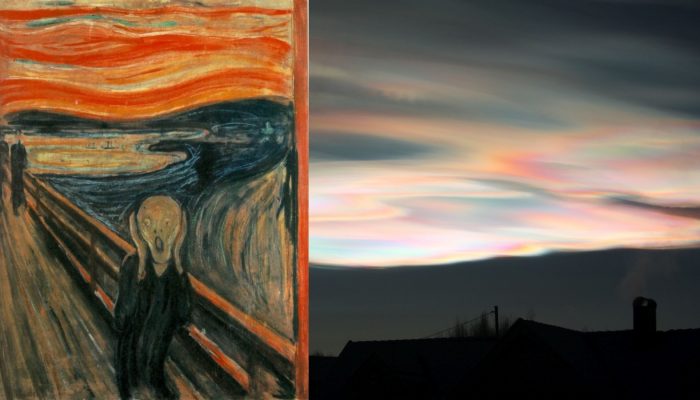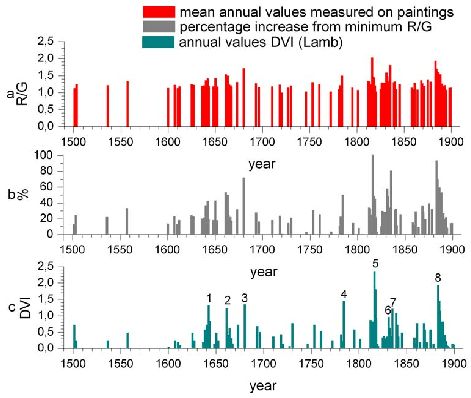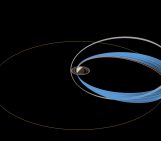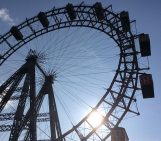
Edvard Munch’s series of paintings and sketches ‘The Scream’ are some of the most famous works by a Norwegian artist, instantly recognisable and reproduced the world over. But what was the inspiration behind this striking piece of art?
The lurid colours and tremulous lines have long been thought to represent Munch’s unstable state of mind; a moment of terror caught in shocking technicolour. At the same time, scientists have recently identified the connection between the great works of artists such as William Turner and the red and orange sunsets which can be a result of the global impact of volcanic aerosols. However, research presented this week at the European Geosciences Union General Assembly in Vienna by atmospheric scientists in Oslo Norway, suggests that the painting might show us evidence of something much stranger, and rarer – nacreous clouds.
Nacreous or mother-of-pearl clouds, are an extremely rare form of cloud created 20-30km above sea level – in the polar stratosphere when the air is extremely cold (between -80 and -85 degrees centigrade) and exceptionally humid,. So far observed mostly in the Scandinavian countries, these clouds are formed of microscopic and uniform particles of ice, orientated into thin clouds. When the sun is below the horizon (before sunrise or after sunset), these clouds are illuminated in a surprisingly vibrant way blazing across the sky in swathes of red, green, blue and silver. They have a distinctive wavy structure as the clouds are formed in the lee-waves behind mountains.
In 2014, these clouds were seen again over the skies of Oslo and given their extreme colouration and unexpected appearance, a photographer, Svein Fikke, immediately thought of Munch’s work. This perceived similarity between the mother of pearl clouds and the striking clouds and sense of tension in the painting is only reinforced when reading Munch’s writings about his experiences on the day that inspired the painting.
“I went along the road with two friends – the sun set
I felt like a breath of sadness –
– The sky suddenly became bloodish red
I stopped, leant against the fence, tired to death – watched over the
Flaming clouds as blood and sword
The city – the blue-black fjord and the city
– My friends went away – I stood there shivering from dread – and
I felt this big, infinite scream through nature”
Edvard Munch’s Diary Notes 1890-1892 (Tøjner and Gundersen, 2013)
Scientists have, in the past, used artworks to infer environmental conditions; from paintings of the ‘frost fairs’ held on the River Thames that show the gradual environmental change in Europe, to the discovery that several artists depict the influence of volcanic aerosols on global atmosphere in their paintings.
In a study conducted in 2007 (and 2014), scientists found that the visible impact that volcanic aerosols have on the atmosphere has in fact been recorded in the works of many of the great masters – particularly William Turner (Zerefos et al, 2007)). Several of Turner’s paintings depict sunsets with a distinct red/orange hue, distinct from his usual work of other years. This was correlated with significant volcanic eruptions in the same time period and the researchers found that these reddish paintings were all created in the years of, or immediately following, a major eruption (shown in the graph below).

Graph to show the relationship between colour and volcanic aerosols (a)The mean annual value of R/G measured on 327 paintings. (b)The percentage increase from minimum R/G value shown in (a). (c)The corresponding Dust Veil Index (DVI). The numbered picks correspond to different eruptions as follows: 1. 1642 (Awu, Indonesia-1641), 2. 1661 (Katla, Iceland-1660), 3. 1680 (Tongkoko and Krakatau, Indonesia-1680), 4. 1784 (Laki, Iceland-1783), 5. 1816 (Tambora, Indonesia-1815), 6. 1831 (Babuyan, Philippines-1831), 7. 1835 (Coseguina, Nicaragua-1835). 8. 1883 (Krakatau, Indonesia-1883). From Zerefos et al (2007).
For many years ‘The Scream’ was thought to also show the influence of a volcanic eruption, most likely the catastrophic eruption of Krakatoa in 1883 (described here by Volcanologist David Pyle), but whereas volcanic skies tend to tint the whole sky a red/orange, the skies in the scream have a distinct pattern, only seen in these extremely rare nacreous clouds.
How rare are they? Well, researcher Dr Helene Muri, a researcher based at the University of Oslo, who presented the research at the press conference, said that in her lifetime living mostly in Norway as an atmospheric researcher she has only seen them once. And what about Munch’s feeling of dread and ‘breath of sadness’?
Well, having a glowing swathe of iridescent petrol coloured clouds flare into bright relief after sunset, only for them to disappear 30 minutes later would be pretty shocking for any of us, even in our modern days of fluorescent streetlamps and light polluted skies.
By Hazel Gibson, EGU Press Assistant at the EGU 2017 General Assembly





Jacqui
Recently sailed from Bergen north across the Arctic Circle and saw such clouds. They would appear and disappear over the course of sunrise
Want to attach a picture but not possible
jeff
I live in Oslo. In the winter, december and january, we get winter sunsets like this ocassionally but often enough.
But they are not irridescent as suggested here. That occurs too, but the clouds Munch painted were simply clouds! intense red, orange and yellow across the western sky. Completely normal, no vulcano and no irridescene. to be sure, the irridescence/ice crystals also occur at this time – but they are different in nature from the clouds… We have had an intense year of this kind in the winter of 2019 and 2020.
Pingback: Edvard Munch and Nacreous Clouds | Green Comet
Pingback: Climate and Agriculture in the Southeast | Are the clouds in “The Scream” volcanic or nacreous clouds?
Pingback: Climate and Agriculture in the Southeast | Are the clouds in “The Scream” volcanic or nacreous clouds?You may